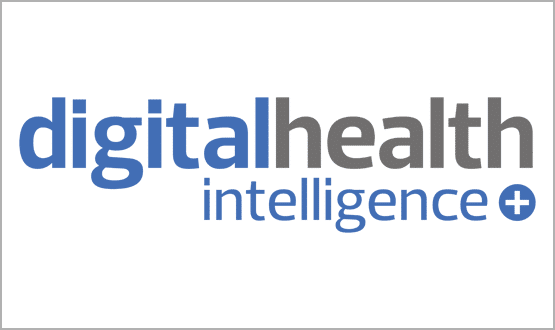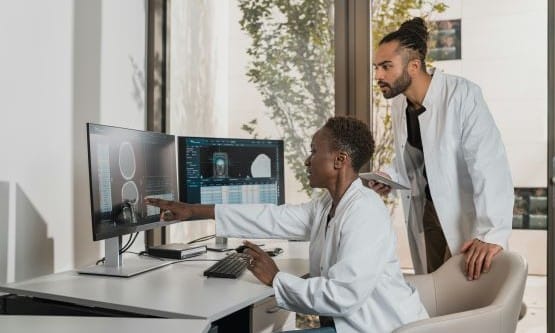PACS – worth the hype?
- 5 October 2007
‘Your doctor will never look at you in the same way again’, so the DH boasted at the completion of the Picture Archiving and Communications Systems (PACS) installations across London and the South this June.
EHI headed to the picturesque town of Chertsey, home of Thorpe Park and St Peter’s Hospital, part of the Ashford and St Peter’s Hospitals NHS Trust, to find out more.
Here (St Peter’s, not Thorpe Park) we met Dr Michael Creagh, consultant radiologist for the trust. Asked why a doctor will ‘never look at us in the same way’, he demonstrated the answer using a large projector in the hospital’s X-ray department.
Several shots of a brain and skull were displayed on a large 3MP monitor and beamed onto the larger still projection screen. With a touch of the mouse, Dr Creagh zoomed into the image, to exacting magnification.
 |
Amazingly, he was able to get all the views he needed from just one image and could zoom in to any specific part, enabling him to provide a detailed x-ray report quickly and easily.
“The great thing about PACS is that any authorised user on the trust network at any given location can gain access to the images and provide a report on it. The web-browser based application means we can access it anywhere and use the images in rooms like this for discussion between radiologists and consultants, surgeons and even GPs.”
The hospital has been using the system for over 18 months now after a phased go-live, and has been encouraging active engagement. Every week, the seminar rooms hosts 22 meetings between clinicians and radiologists from the different departments where the PACS images can be seen up close and in high resolution.
“The multi-disciplinary meetings are particularly useful for sensitive cases, such as cancer cases. Each department will have physicians or surgeons who can discuss this with us in more detail maximising patient safety. Of course, this also involves a lot of waiting to be seen, which can be relatively burdensome.”
Dr Creagh has been a key person behind PACS in the trust since the business case was approved by the board. The trust were meant to be the first to implement PACS in the South, but a determination to ensure the UK version of the US-based GE product was as bug-free and anglicised as possible, delayed the go-live.
“GE is a mature US product, but there are large differences between how US radiology and UK radiology are undertaken, which had to be considered, such as the amount of complex coding which US radiologists have to work with and we don’t. For us, it was essential that the new RIS [Radiology Information System] and PACS would interface with our Torex PAS and provide patient record details for each patient having a scan.”
This took eight months to achieve to ensure that the HSS RIS and GE PACS would integrate with the order comms functionality of the Torex/iSoft PAS so that all order notes were present on a patient’s digital image file.
The system was agreed ready for deployment in December 2005 and installation began in January 2006.
At the same time, the trust began its merger and moved all radiology services to the St Peter’s site.
“For us, PACS came at exactly the right time. We were able to move our 13 radiologists across to the St Peters site, and do away with individual offices for each of us, because we no longer needed the space for film analysis. It also meant we changed the way we worked, being at one site meant we no longer worked standard hours, but were moved to shift work.”
The hospital’s renovated X-Ray department now boasts three rooms where radiologists can sit and view PACS. According to Dr Creagh, the radiologists were ‘jubilant’ at the permanent move ‘because we no longer had to sit on the worst stretch of the M25 motorway to travel between sites at all hours of the day.’
As well as the seminar room, for a large clear vision of the images for large groups of people to observe and comment on, radiologists also have a hidden ‘sanctuary’, known by them as the ‘nerve centre’ and the ‘PACS hub’.
Here, each radiologist gets their own desk where they can analyse images using 13 inch lightweight Sony Vaio laptops or head into the hub to see images on large screen monitors.
Dr Creagh jokes: “Most users are happy with their low-resolution 1MP screens, but occasionally we have consultants who develop ‘monitor envy’ condition – I doubt the board sympathises!”
However, both he and his colleagues insist they wouldn’t want to go back to the days of film.
“Film is very demoralising and tiresome. There is more space now as images are stored on a computer and not in packets of films, that storage expense has been lost and we now have a cleaner workplace as there are no more issues around chemical processing. The trust is also saving with no more expensive film and chemicals required for processing.”
Now, Dr Creagh and his radiology colleagues can access images from anywhere, logging onto the trust network anywhere they can gain access to the VPN.
“We can now react instantly to latest scan results and take necessary action using our laptops wherever we are. It is a lightweight convenient method of collecting results that we didn’t have before.”
The trust has been provided with a server from Fujitsu which is capable of holding roughly the equivalent of a year’s worth of data.
“All our data is backed up remotely in a secure data centre and we store data locally for one year. After that, it is difficult to get hold of again – no one’s really thought about that. An interface is being worked on for us to share across the cluster, but we’re not actively using that yet, at the moment it is only data from the Surrey Health Informatics Services (HIS) region that we can work from.”
Another problem facing the department is obtaining trust support after office hours when the helpdesk is closed.
“If anything happens to the IT in the trust, which national suppliers can’t help with, then we’re left waiting for the next working day and hour before we can get it resolved – it is a bit of a hinderance,” Dr Creagh explains.
 |
Speech recognition is also causing some transcription problems: “Sometimes, the software chooses the wrong words, and out of hours, with no-one to check it, that can be a real danger to their parent. There are certainly some creases to iron out here.”
All of these are issues which Dr Creagh expects to tackle now the system is live everywhere, except the mammography department.
“There are some rough edges we will need to sort with the suppliers bit by bit so that the system becomes more robust and we can provide the HIS community with the best possible service.
“We will introduce a wireless network so we can use PACS on wards, and we will continue to work with the CRS team to ensure the PAS integration already in place is not lost when Millennium is installed.”
Dr Creagh was unable to provide EHI with financial figures to demonstrate the benefits, but added: “PACS has given us an end to traipsing round a hospital or between sites with the large envelopes that contain their x-rays and scans, instead we have clinical images being instantly available on screen – so goodbye to lost x-rays and ‘lost in transit’ stories.”




